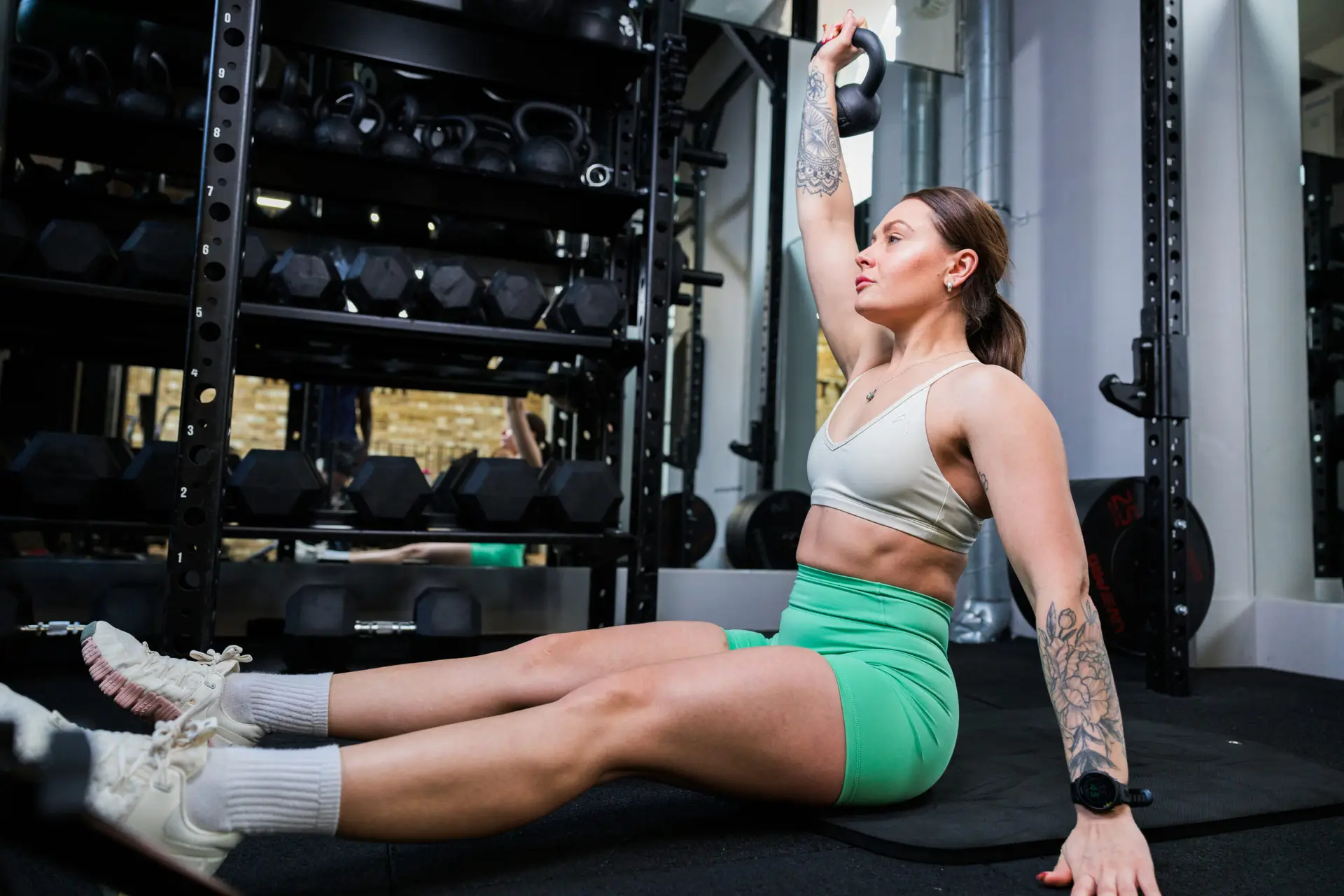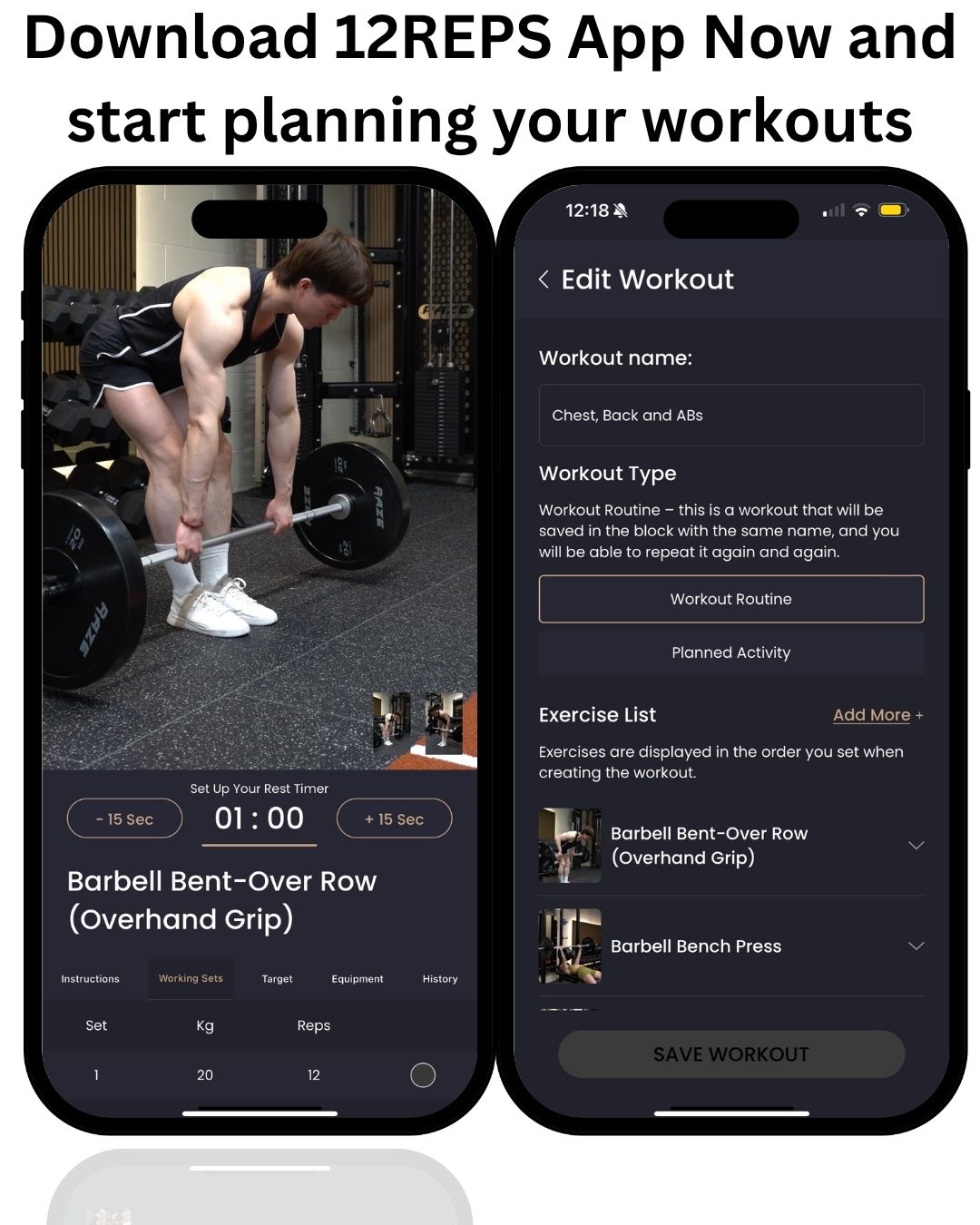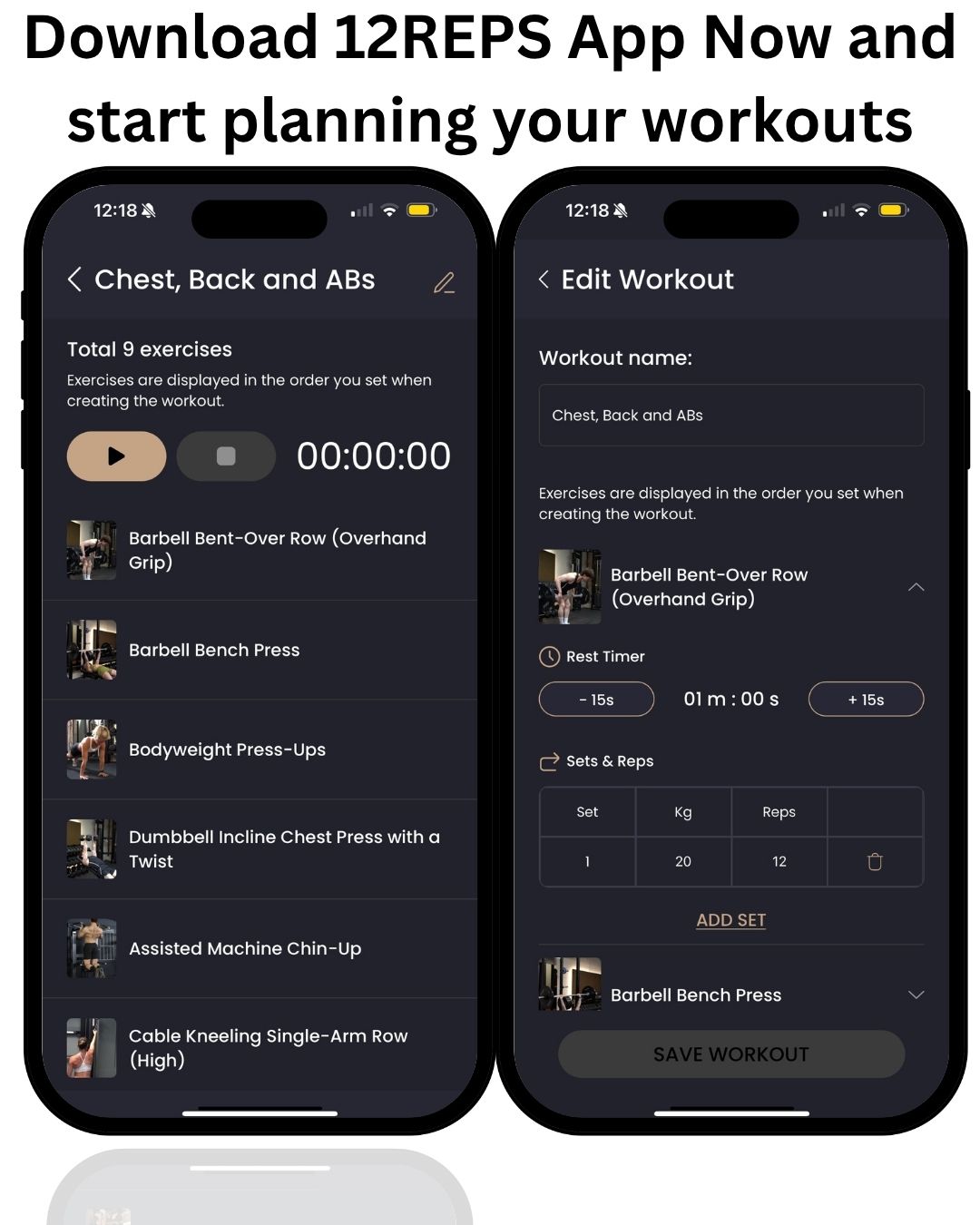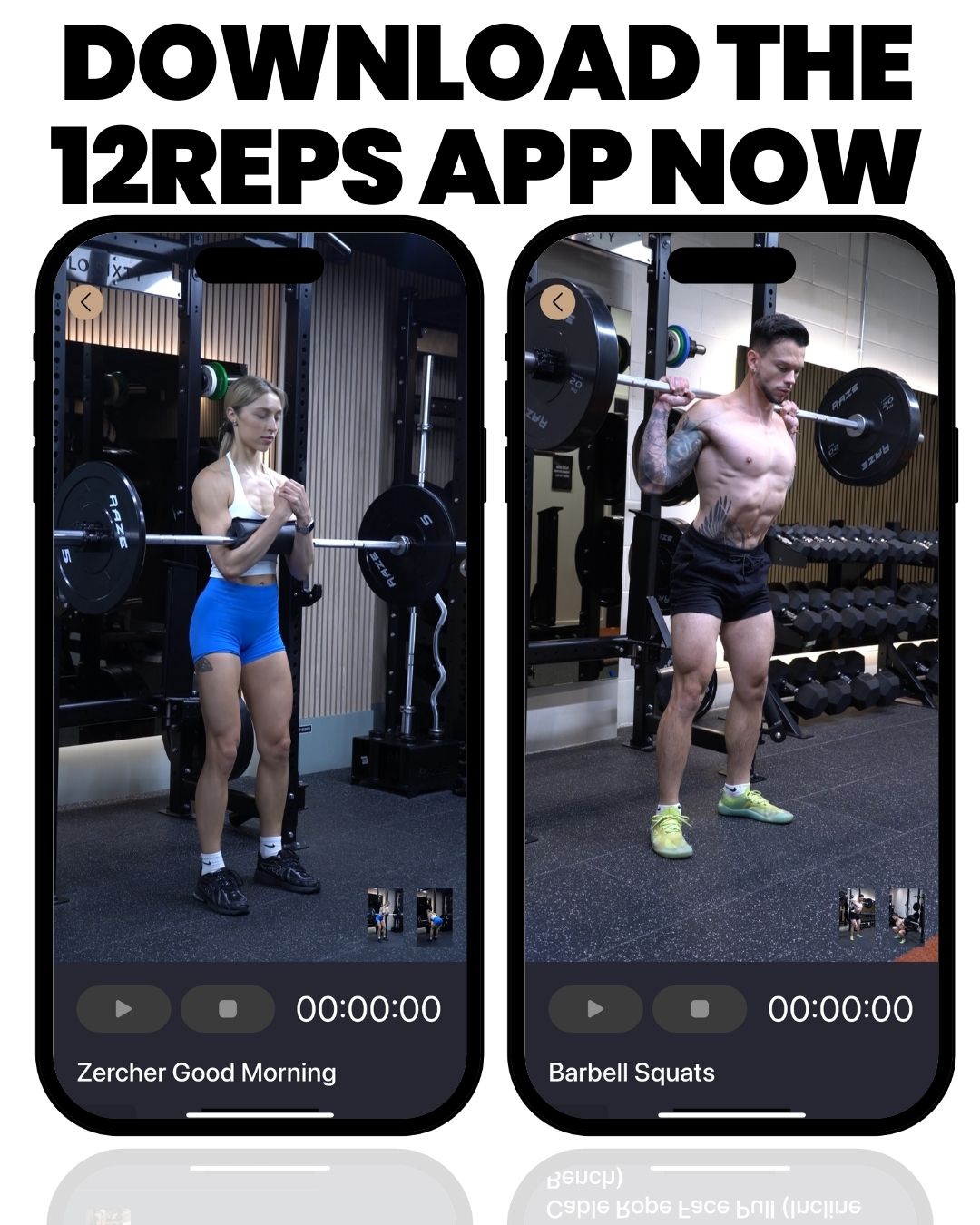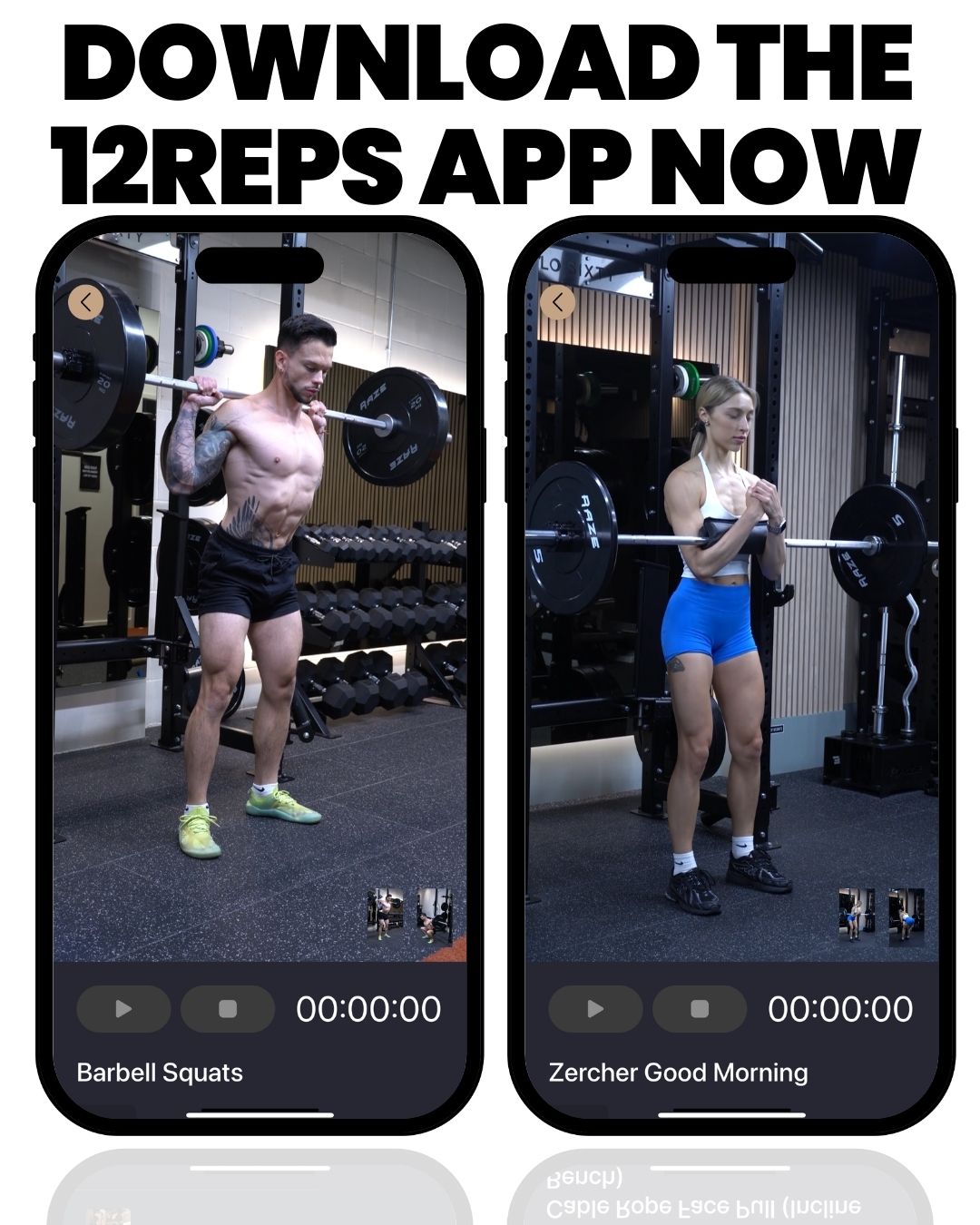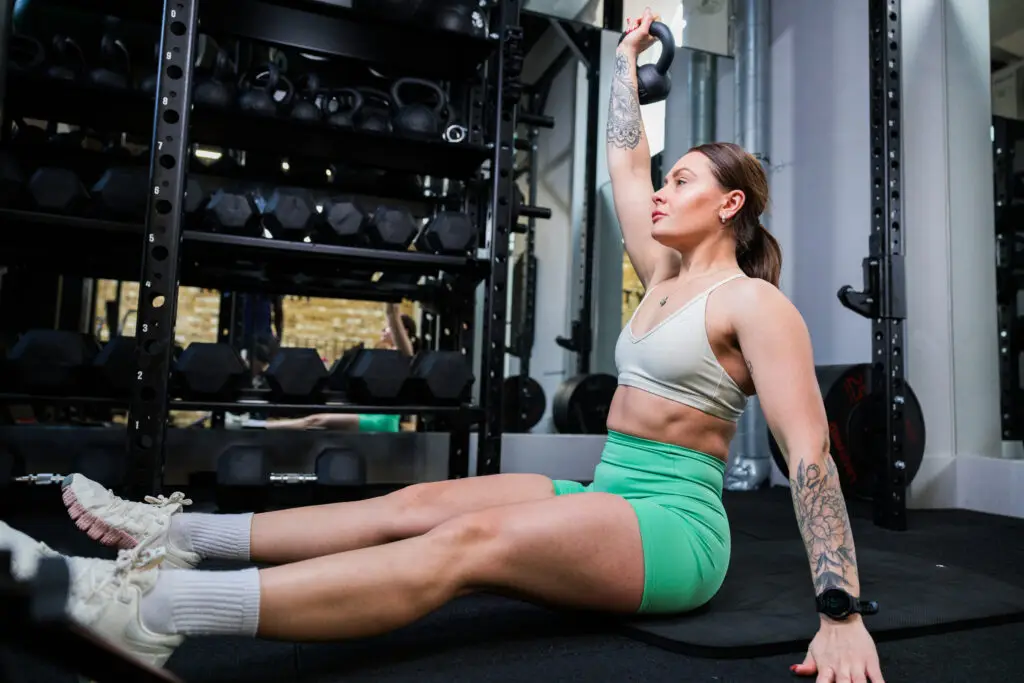Written by Will Duru, BSc (Hons) Sport and Exercise Science, Award-winning Personal Trainer with over 10 years of experience in strength training and optimising recovery.
If you’re a runner who’s hit a performance plateau, you’re not alone. Many runners spend countless hours pounding the pavement, believing that more miles equals better performance. However, research shows that the missing piece in most runners’ training isn’t more running, it’s strategic strength training [1].
As a sport and exercise scientist with over a decade of experience training athletes, I’ve seen firsthand how proper strength training transforms running performance. The push/pull/legs methodology, combined with targeted core work, creates a balanced approach that enhances running economy whilst reducing injury risk.
This 12-week program is designed specifically for advanced runners who want to take their performance to the next level. Unlike generic gym programs, every exercise has been selected for its direct transfer to running performance. The program uses a two-phase approach with progressive overload principles to ensure continuous adaptation and improvement.

The Science Behind Strength Training for Runners
Running is a repetitive, single-leg activity that places enormous demands on your body. With each stride, you absorb forces equivalent to 2-3 times your body weight. Without adequate strength, these forces lead to fatigue, poor form, and eventually injury.
Research published in the Journal of Strength and Conditioning Research demonstrates that runners who incorporate strength training improve their running economy by 3-8% [2]. This improvement translates directly to faster race times and reduced perceived effort during training runs.
The key benefits of strength training for runners include:
Enhanced Running Economy: Stronger muscles require less oxygen to produce the same force output. This means you can maintain faster paces with less effort, particularly important during longer races.
Improved Power Output: Strength training increases your ability to generate force quickly. This enhanced power translates to more efficient stride mechanics and better performance in hills and sprint finishes.
Injury Prevention: Strong muscles, tendons, and ligaments better withstand the repetitive stress of running. Studies show that runners who strength train experience 50% fewer injuries compared to those who only run [3].
Better Running Form: Fatigue-resistant muscles maintain proper form longer. This is crucial during the latter stages of races when form typically deteriorates.
Why Push/Pull/Legs Works for Runners
The push/pull/legs split divides your training into three distinct movement patterns, allowing for optimal recovery whilst maintaining training frequency.
This approach is particularly effective for runners because it:
Maximises Recovery: By training different muscle groups on different days, you allow adequate recovery time whilst maintaining a high training frequency.
Addresses Runner Imbalances: Most runners develop strength imbalances due to the repetitive nature of running. This program specifically targets commonly weak areas like the glutes, core, and upper body.
Fits Your Schedule: With only four sessions per week, this program integrates seamlessly with your running training without causing excessive fatigue.
Provides Progressive Structure: The systematic approach ensures you’re always challenging your body appropriately, leading to continuous improvements.
Understanding Single-Leg Training for Runners
Running is fundamentally a single-leg activity. At any given moment, you’re supported by one leg whilst the other swings through. This is why single-leg exercises form the foundation of this program’s leg training.
Single-leg exercises offer several advantages over bilateral movements:
Specificity: They closely mimic the demands of running, improving the transfer of strength gains to performance.
Balance and Stability: Single-leg training challenges your proprioceptive system, improving balance and reducing injury risk.
Imbalance Correction: These exercises reveal and correct strength differences between legs, which are common in runners.
Core Integration: Single-leg exercises require significant core activation, providing additional stability training.
The leg exercises in this program include single-leg press, single-leg extension, and single-leg curl. These machine-based exercises allow for controlled loading whilst maintaining the single-leg specificity crucial for runners.
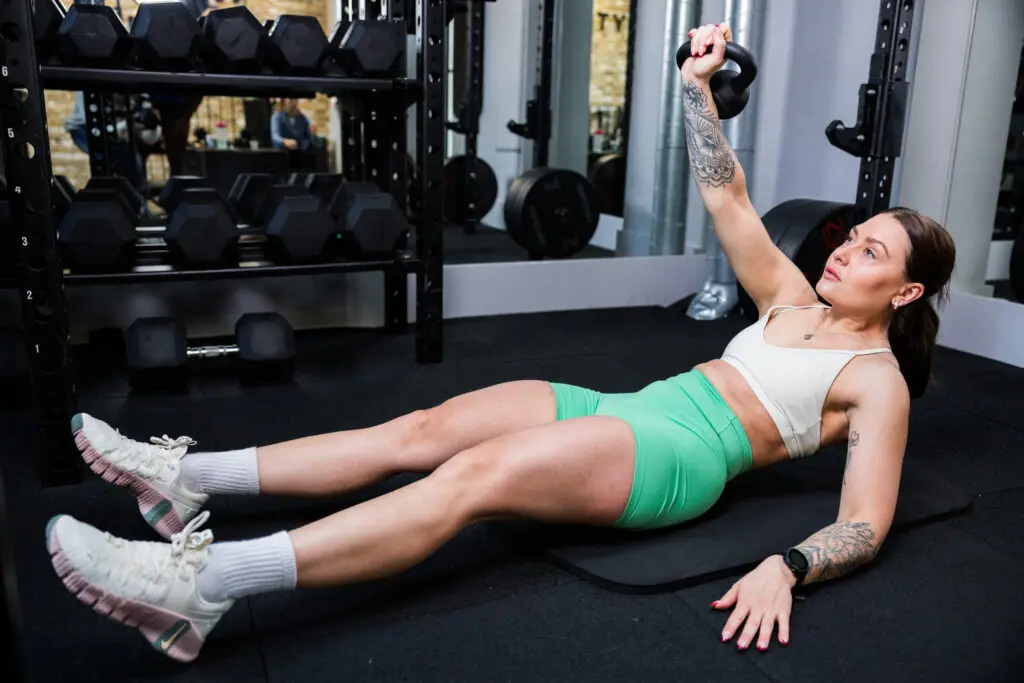
Program Overview: Two-Phase Approach
This 12-week program is divided into two distinct phases, each designed to build upon the previous one:
Phase 1 (Weeks 1-6): Foundation Building
•4 sets of 10-12 repetitions
•Focus on movement quality and adaptation
•Moderate weights with emphasis on form
•Building work capacity and strength endurance
Phase 2 (Weeks 7-12): Strength Development
•5 sets of 8-10 repetitions
•Increased weights and intensity
•Focus on maximal strength development
•Enhanced power and performance transfer
Throughout both phases, progressive overload is applied systematically. This means gradually increasing the demands placed on your muscles through increased weight, additional sets, or enhanced exercise difficulty.
Training Schedule and Structure
The program follows a four-day training schedule that integrates perfectly with most running programs:
Monday: Push + Core (Upper body pushing muscles and core stability) Tuesday: Running or Rest Wednesday: Pull + Core (Upper body pulling muscles and core strength) Thursday: Running or Rest Friday: Legs (Single-leg focused lower body training) Saturday: Running (Long run or tempo work) Sunday: Rest or Easy Recovery Run
This schedule ensures adequate recovery between strength sessions whilst allowing flexibility for your running training. The 12reps app provides detailed exercise demonstrations and progress tracking to support your training journey.

Push Day Workouts: Building Upper Body Power
Push day focuses on the muscles responsible for pushing movements: chest, shoulders, and triceps. For runners, these muscles are crucial for maintaining proper posture and efficient arm swing, particularly during longer efforts when fatigue sets in.
The push muscles work together to maintain your upper body position and contribute to forward momentum through coordinated arm swing. Weak push muscles lead to slouched posture, inefficient breathing, and wasted energy during running.
Push Day Warm-up and Mobility (10-12 minutes)
Proper preparation is essential for effective push day training. This warm-up sequence prepares your shoulders, chest, and core whilst addressing common runner tightness patterns.
General Warm-up (3-4 minutes):
•Light cardio: 3-4 minutes of easy jogging on the spot or stationary bike
•Arm circles: 10 forward, 10 backwards each direction
•Shoulder shrugs: 10 repetitions
Dynamic Mobility Sequence (4-5 minutes):
•World’s Greatest Stretch: 5 repetitions each side, holding for 3 seconds
•Step into a lunge position, place the opposite hand on the ground
•Rotate towards the front leg, reaching the arm towards the ceiling
•Excellent for hip flexors, thoracic spine, and shoulders
•Arm swings: 10 repetitions each direction
•Forward and backwards, then across the body
•Prepares shoulders for pressing movements
•Cat-cow stretches: 8-10 repetitions
•Mobilises the thoracic spine for overhead pressing
•Activates core muscles
Activation Exercises (3-4 minutes):
•Mini band chest flies: 12-15 repetitions with light resistance
•Activates chest and rear deltoids
•Prepares shoulders for pressing patterns
•Wall slides: 10-12 repetitions
•Stand with back against wall, slide arms up and down
•Activates postural muscles and shoulder stability
•Plank hold: 30 seconds
•Activates core for stability during pressing exercises
Phase 1 Push Day Workout (Weeks 1-6)
| Exercise | Weight | Sets | Reps | Rest Period |
| Push-ups (or Incline Push-ups) | Bodyweight | 4 | 10-12 | 60-90 seconds |
| Dumbbell Chest Press | 60-70% 1RM | 4 | 10-12 | 90 seconds |
| Overhead Press (Dumbbells) | 60-70% 1RM | 4 | 10-12 | 90 seconds |
| Incline Dumbbell Press | 60-70% 1RM | 4 | 10-12 | 90 seconds |
| Tricep Dips | Bodyweight | 4 | 10-12 | 60 seconds |
| Plank Hold | Bodyweight | 4 | 30-45 seconds | 60 seconds |
| Dead Bug | Bodyweight | 4 | 10-12 each side | 45 seconds |
Progressive Overload for Phase 1: Increase weight by 2.5-5% when you can complete all sets and reps with perfect form. Focus on movement quality over heavy weights during this foundation phase.
Phase 2 Push Day Workout (Weeks 7-12)
| Exercise | Weight | Sets | Reps | Rest Period |
| Push-ups (Advanced Variation) | Bodyweight + | 5 | 8-10 | 90 seconds |
| Barbell Bench Press | 75-85% 1RM | 5 | 8-10 | 2-3 minutes |
| Overhead Press (Barbell) | 75-85% 1RM | 5 | 8-10 | 2-3 minutes |
| Incline Barbell Press | 75-85% 1RM | 5 | 8-10 | 2 minutes |
| Close-Grip Bench Press | 70-80% 1RM | 5 | 8-10 | 90 seconds |
| Plank to Push-up | Bodyweight | 5 | 8-10 | 60 seconds |
| Palloff Press | Moderate resistance | 5 | 8-10 each side | 45 seconds |
Progressive Overload for Phase 2: Increase weight by 2.5-5kg when you can complete all sets and reps. The focus shifts to building maximal strength whilst maintaining movement quality.
The 12reps app provides detailed video demonstrations for each exercise, ensuring proper form and technique. Download 12reps to access comprehensive exercise libraries and progress tracking tools.
Push Day Workouts: Building Upper Body Power
Push day focuses on the muscles responsible for pushing movements: chest, shoulders, and triceps. For runners, these muscles are crucial for maintaining proper posture and efficient arm swing, particularly during longer efforts when fatigue sets in.
The push muscles work together to maintain your upper body position and contribute to forward momentum through coordinated arm swing. Weak push muscles lead to slouched posture, inefficient breathing, and wasted energy during running.
Push Day Warm-up and Mobility (10-12 minutes)
Proper preparation is essential for effective push day training. This warm-up sequence prepares your shoulders, chest, and core whilst addressing common runner tightness patterns.
General Warm-up (3-4 minutes):
•Light cardio: 3-4 minutes of easy jogging on the spot or stationary bike
•Arm circles: 10 forward, 10 backwards each direction
•Shoulder shrugs: 10 repetitions.
Dynamic Mobility Sequence (4-5 minutes):
•World’s Greatest Stretch: 5 repetitions each side, holding for 3 seconds
•Step into lunge position, place the opposite hand on the ground
•Rotate towards the front leg, reaching arm towards the ceiling
•Excellent for hip flexors, thoracic spine, and shoulders
•Arm swings: 10 repetitions each direction
•Forward and backwards, then across the body
•Prepares shoulders for pressing movements
•Cat-cow stretches: 8-10 repetitions
•Mobilises thoracic spine for overhead pressing
•Activates core muscles.
Activation Exercises (3-4 minutes):
•Mini band chest flies: 12-15 repetitions with light resistance
•Activates chest and rear deltoids
•Prepares shoulders for pressing patterns
•Wall slides: 10-12 repetitions
•Stand with back against wall, slide arms up and down
•Activates postural muscles and shoulder stability
•Plank hold: 30 seconds
•Activates core for stability during pressing exercises
Phase 1 Push Day Workout (Weeks 1-6)
| Exercise | Weight | Sets | Reps | Rest Period |
| Push-ups (or Incline Push-ups) | Bodyweight | 4 | 10-12 | 60-90 seconds |
| Dumbbell Chest Press | 60-70% 1RM | 4 | 10-12 | 90 seconds |
| Overhead Press (Dumbbells) | 60-70% 1RM | 4 | 10-12 | 90 seconds |
| Incline Dumbbell Press | 60-70% 1RM | 4 | 10-12 | 90 seconds |
| Tricep Dips | Bodyweight | 4 | 10-12 | 60 seconds |
| Plank Hold | Bodyweight | 4 | 30-45 seconds | 60 seconds |
| Dead Bug | Bodyweight | 4 | 10-12 each side | 45 seconds |
Progressive Overload for Phase 1: Increase weight by 2.5-5% when you can complete all sets and reps with perfect form. Focus on movement quality over heavy weights during this foundation phase.
Phase 2 Push Day Workout (Weeks 7-12)
| Exercise | Weight | Sets | Reps | Rest Period |
| Push-ups (Advanced Variation) | Bodyweight + | 5 | 8-10 | 90 seconds |
| Barbell Bench Press | 75-85% 1RM | 5 | 8-10 | 2-3 minutes |
| Overhead Press (Barbell) | 75-85% 1RM | 5 | 8-10 | 2-3 minutes |
| Incline Barbell Press | 75-85% 1RM | 5 | 8-10 | 2 minutes |
| Close-Grip Bench Press | 70-80% 1RM | 5 | 8-10 | 90 seconds |
| Plank to Push-up | Bodyweight | 5 | 8-10 | 60 seconds |
| Palloff Press | Moderate resistance | 5 | 8-10 each side | 45 seconds |
Progressive Overload for Phase 2: Increase weight by 2.5-5kg when you can complete all sets and reps. The focus shifts to building maximal strength whilst maintaining movement quality.
The 12reps app provides detailed video demonstrations for each exercise, ensuring proper form and technique.
Pull Day Workouts: Developing Posterior Chain Strength
Pull day targets the muscles responsible for pulling movements: back, biceps, and posterior chain. These muscles are often underdeveloped in runners, leading to poor posture and inefficient movement patterns.
Strong pull muscles maintain proper spinal alignment, support efficient breathing mechanics, and provide the stability needed for powerful arm swing. The posterior chain, including the glutes and hamstrings, generates the majority of propulsive force during running.
Pull Day Warm-up and Mobility (10-12 minutes)
Pull day preparation focuses on activating the posterior chain whilst addressing forward head posture and rounded shoulders common in runners.
General Warm-up (3-4 minutes):
•Light cardio: 3-4 minutes of easy movement
•Arm circles: 10 each direction, emphasising backwards circles
•Neck rolls: 5 each direction, slow and controlled
Dynamic Mobility Sequence (4-5 minutes):
•World’s Greatest Stretch with Rotation: 5 repetitions each side
•Add thoracic rotation to target upper back mobility
•Hold rotation for 2-3 seconds in each direction
•Band pull-aparts: 15-20 repetitions with light resistance
•Activates rear deltoids and rhomboids
•Counteracts forward shoulder posture
•Thoracic spine extensions: 8-10 repetitions
•Hands behind head, extend through the upper back
•Prepares the spine for rowing movements
Posterior Chain Activation (3-4 minutes):
•Glute bridges: 12-15 repetitions
•Activates glutes for deadlift preparation
•Counters hip flexor tightness from running
•Band rows: 15-20 repetitions with light resistance
•Activates latissimus dorsi and rhomboids
•Prepares pulling muscles for training
•Dead bugs: 8-10 each side
•Activates deep core stabilisers
•Prepares core for anti-extension during deadlifts
Phase 1 Pull Day Workout (Weeks 1-6)
| Exercise | Weight | Sets | Reps | Rest Period |
| Bent-over Dumbbell Row | 60-70% 1RM | 4 | 10-12 | 90 seconds |
| Lat Pulldown | 60-70% 1RM | 4 | 10-12 | 90 seconds |
| Romanian Deadlift | 60-70% 1RM | 4 | 10-12 | 2 minutes |
| Seated Cable Row | 60-70% 1RM | 4 | 10-12 | 90 seconds |
| Face Pulls | Light-moderate | 4 | 10-12 | 60 seconds |
| Side Plank | Bodyweight | 4 | 30-45 seconds each | 60 seconds |
| Bird Dog | Bodyweight | 4 | 10-12 each side | 45 seconds |
Progressive Overload for Phase 1: Focus on feeling the correct muscles working. Increase weight gradually when you can maintain perfect form throughout all sets.
Phase 2 Pull Day Workout (Weeks 7-12)
| Exercise | Weight | Sets | Reps | Rest Period |
| Barbell Bent-over Row | 75-85% 1RM | 5 | 8-10 | 2-3 minutes |
| Pull-ups/Chin-ups | Bodyweight + | 5 | 8-10 | 2-3 minutes |
| Conventional Deadlift | 75-85% 1RM | 5 | 8-10 | 3 minutes |
| T-Bar Row | 75-85% 1RM | 5 | 8-10 | 2 minutes |
| Cable Face Pulls | Moderate-heavy | 5 | 8-10 | 90 seconds |
| Side Plank with Rotation | Bodyweight | 5 | 8-10 each side | 60 seconds |
| Single-arm Farmer’s Walk | Heavy | 5 | 20-30 steps each | 90 seconds |
Progressive Overload for Phase 2: Emphasise strength development with heavier weights. Add weight plates for pull-ups when bodyweight becomes manageable.
Leg Day Workouts: Single-Leg Strength and Power
Leg day is where runners see the most direct performance benefits. This session focuses exclusively on single-leg exercises that closely mimic the demands of running whilst building strength, power, and stability.
The single-leg approach ensures balanced development between legs whilst challenging your stability and proprioceptive systems. This translates directly to improved running efficiency and reduced injury risk.
Leg Day Warm-up and Mobility (15-18 minutes)
Leg day requires the most comprehensive warm-up due to the complexity and intensity of single-leg exercises. This extended preparation addresses runner-specific tightness patterns whilst activating key stabilising muscles.
Foam Rolling Sequence (5-6 minutes):
•IT Band foam rolling: 60-90 seconds each leg
•Roll from hip to knee, pause on tender spots
•Essential for runners with lateral knee issues
•Calf muscle foam rolling: 45-60 seconds each leg
•Target both the gastrocnemius and the soleus
•Include the Achilles tendon area
•Quad foam rolling: 60-90 seconds each leg
•Roll from hip to knee, including vastus lateralis
•Critical for runners with anterior knee pain
•Hamstring foam rolling: 45-60 seconds each leg
•Focus on areas of tightness
•Include the glute-hamstring junction
•Glute foam rolling: 45-60 seconds each side
•Target piriformis and gluteus medius
•Essential for hip stability
Dynamic Mobility Sequence (5-6 minutes):
•World’s Greatest Stretch: 6 repetitions each side
•Hold for 5 seconds, emphasise the hip flexor stretch
•Add thoracic rotation for complete mobility
•Pigeon Stretch (dynamic): 5 repetitions each side
•From downward dog, bring the knee to the elbow
•Return to downward dog, repeat
•Targets hip flexors and external rotators
•Leg swings: 10 each direction, each leg
•Forward/backwards and side to side
•Prepares hips for multi-directional movement
•Walking lunges with rotation: 8-10 total steps
•Add thoracic rotation towards the front leg
•Combines mobility with activation
Mini Band Activation (4-5 minutes):
•Mini band crab walks: 10 steps each direction
•Maintain squat position, step laterally
•Activates the gluteus medius for hip stability
•Mini band knee tucks: 12-15 repetitions each leg
•Standing position, drive the knee up against the band resistance
•Activates hip flexors and core
•Mini band monster walks: 8-10 steps forward and backwards
•Diagonal steps with a band around the ankles
•Challenges glutes in multiple planes
•Mini band glute bridges: 15-20 repetitions
•Band around knees, squeeze glutes at the top
•Activates glutes for single-leg exercises
Single-Leg Preparation (2-3 minutes):
•Single-leg balance: 30 seconds each leg
•Eyes open, then eyes closed
•Prepares the proprioceptive system
•Single-leg glute bridges: 8-10 each leg
•Slow and controlled movement
•Final glute activation before training
Phase 1 Leg Day Workout (Weeks 1-6)
| Exercise | Weight | Sets | Reps | Rest Period |
| Single-leg Press | 60-70% bilateral max | 4 | 10-12 each leg | 2 minutes |
| Single-leg Extension | 60-70% bilateral max | 4 | 10-12 each leg | 90 seconds |
| Single-leg Curl | 60-70% bilateral max | 4 | 10-12 each leg | 90 seconds |
| Single-leg Calf Raise | Bodyweight + | 4 | 10-12 each leg | 60 seconds |
| Single-leg Glute Bridge | Bodyweight | 4 | 10-12 each leg | 60 seconds |
| Single-leg Deadlift | Light dumbbells | 4 | 10-12 each leg | 90 seconds |
| Single-leg Balance | Bodyweight | 4 | 30-45 seconds each | 45 seconds |
Progressive Overload for Phase 1: Start with lighter weights to master the single-leg movement patterns. Increase weight when you can maintain perfect balance and control throughout the range of motion.
Phase 2 Leg Day Workout (Weeks 7-12)
| Exercise | Weight | Sets | Reps | Rest Period |
| Single-leg Press | 75-85% bilateral max | 5 | 8-10 each leg | 2-3 minutes |
| Single-leg Extension | 75-85% bilateral max | 5 | 8-10 each leg | 2 minutes |
| Single-leg Curl | 75-85% bilateral max | 5 | 8-10 each leg | 2 minutes |
| Weighted Single-leg Calf Raise | Heavy dumbbells | 5 | 8-10 each leg | 90 seconds |
| Single-leg Hip Thrust | Weighted | 5 | 8-10 each leg | 90 seconds |
| Single-leg Romanian Deadlift | Heavy dumbbells | 5 | 8-10 each leg | 2 minutes |
| Single-leg Box Step-up | Weighted | 5 | 8-10 each leg | 90 seconds |
Progressive Overload for Phase 2: Focus on building maximal single-leg strength. The weights should be challenging whilst maintaining perfect form and control.
Implementation Guidelines: Getting Started
Starting a new strength training program requires careful planning and gradual progression. Here’s how to implement this program effectively whilst maintaining your running performance.
Week 1-2: Foundation Phase
Begin with lighter weights and focus on mastering movement patterns. Your primary goal is learning proper form and allowing your body to adapt to the new training stimulus. Many runners experience initial muscle soreness, which is normal and will decrease as your body adapts.
Start with weights that feel moderately challenging but allow you to complete all sets with perfect form. If you’re unsure about appropriate starting weights, begin conservatively and increase gradually.
Week 3-6: Building Phase
As movement patterns become more natural, begin increasing weights according to the progressive overload principles. You should feel challenged during the last 2-3 repetitions of each set whilst maintaining perfect form.
Monitor your running performance during this phase. You may initially feel some fatigue as your body adapts to the additional training load. This is temporary and will improve as your fitness develops.
Week 7-12: Strength Development Phase
The transition to Phase 2 marks a shift towards maximal strength development. The increased sets and heavier weights require greater focus on recovery and nutrition. Pay particular attention to sleep quality and post-workout nutrition during this phase.
Your running should feel noticeably easier as strength gains begin to transfer to performance. Many runners report improved hill running ability and better maintenance of pace during longer efforts.
Progressive Overload Strategies
Progressive overload is the gradual increase in training demands that drives adaptation and improvement. This program uses several methods to ensure continuous progress:
Weight Progression: The primary method involves increasing weight by 2.5-5% when you can complete all sets and reps with perfect form. For single-leg exercises, this progression may be slower due to the balance and stability demands.
Volume Progression: Moving from 4 sets in Phase 1 to 5 sets in Phase 2 increases training volume, providing a new stimulus for adaptation.
Intensity Progression: The shift from 10-12 reps to 8-10 reps with heavier weights increases training intensity, promoting strength development.
Exercise Progression: Some exercises become more challenging throughout the program, such as progressing from basic planks to plank-to-push-ups.
Track your progress using the 12reps app, which allows you to log weights, sets, and reps whilst providing visual progress tracking. This data helps ensure you’re applying progressive overload consistently.
Integrating Strength Training with Running
Successful integration of strength training with running requires careful attention to timing and recovery. Here’s how to optimise both aspects of your training:
Timing Considerations
Same Day Training: If you must train on the same day, complete your running first when it’s your priority session. For easy runs, strength training can be performed first without significant impact.
Recovery Timing: Allow at least 6 hours between high-intensity running and strength training when possible. This ensures adequate recovery and maintains quality in both sessions.
Weekly Planning: Schedule your hardest running sessions (intervals, tempo runs) on days when you’re not strength training or have completed easier strength sessions.
Managing Training Load
Monitor your overall training stress using subjective measures like perceived exertion and objective measures like resting heart rate. The 12reps app includes recovery tracking features to help manage your training load effectively.
Signs of excessive training load include:
•Persistent fatigue lasting more than 48 hours
•Declining running performance
•Increased resting heart rate
•Poor sleep quality
•Loss of motivation
If you experience these symptoms, reduce training intensity or take an additional rest day.
Nutrition for Strength and Endurance
Proper nutrition supports both strength development and running performance. Your nutritional needs increase when combining strength training with running, particularly regarding protein intake and recovery nutrition.
Protein Requirements
Runners engaging in strength training require 1.6-2.2 grams of protein per kilogram of body weight daily [4]. This increased requirement supports muscle protein synthesis and recovery from both running and strength training.
Distribute protein intake throughout the day, aiming for 20-30 grams per meal. Post-workout protein intake within 2 hours optimises recovery and adaptation.
Carbohydrate Considerations
Maintain adequate carbohydrate intake to fuel both running and strength training. Aim for 5-7 grams per kilogram of body weight daily, adjusting based on training volume and intensity.
Time carbohydrate intake around training sessions, consuming 30-60 grams before strength training and 1-1.5 grams per kilogram of body weight within 2 hours post-exercise.
Hydration Strategies
Increased training volume elevates fluid requirements. Monitor urine colour as a simple hydration assessment tool, aiming for pale yellow throughout the day.
Consume 500-750ml of fluid 2-3 hours before training and 150-250ml every 15-20 minutes during longer sessions.
Recovery and Regeneration
Recovery is when adaptation occurs, making it equally important as the training itself. This program’s design allows for adequate recovery between sessions, but additional recovery strategies enhance results.
Sleep Optimisation
Aim for 7-9 hours of quality sleep nightly. Sleep is when growth hormone release peaks, supporting muscle recovery and adaptation. Create a consistent sleep schedule and optimise your sleep environment for quality rest.
Active Recovery Methods
Light movement on rest days promotes blood flow and aids recovery. Easy walking, gentle swimming, or yoga are excellent active recovery options that don’t interfere with adaptation.
Stress Management
Chronic stress elevates cortisol levels, which can impair recovery and adaptation. Incorporate stress management techniques like meditation, deep breathing, or relaxing hobbies into your routine.
Monitoring Progress and Adaptations
Track both strength and running performance to assess program effectiveness. The 12reps app provides comprehensive tracking tools for strength training metrics, whilst running apps can monitor performance changes.
Strength Metrics
Monitor increases in weights lifted, particularly for the major exercises like leg press, deadlifts, and pressing movements. Aim for consistent progression throughout the 12-week program.
Running Performance Indicators
Look for improvements in:
•Perceived effort at given paces
•Hill running performance
•Ability to maintain pace during longer efforts
•Recovery between running sessions
Body Composition Changes
Strength training often leads to favourable body composition changes, including increased muscle mass and reduced body fat percentage. These changes may not reflect on the scales but contribute to improved performance.
Troubleshooting Common Issues
Every runner will face challenges when implementing a new training program. Here are solutions to common issues:
Time Constraints
If time is limited, prioritise the leg day session as it provides the greatest running-specific benefits. Push and pull sessions can be combined into upper-body sessions when necessary.
Equipment Limitations
The program is designed for gym-based training, but modifications are possible. Resistance bands can substitute for cable exercises, and bodyweight variations can replace some weighted movements.
Plateau Breaking
If progress stalls, consider:
•Deload week with reduced weights
•Exercise variations to provide new stimulus
•Increased rest periods for better recovery
•Nutrition and sleep assessment
Expected Results and Timeline
Realistic expectations help maintain motivation throughout the program. Here’s what to expect
Weeks 1-3: Adaptation Phase
•Initial muscle soreness that gradually decreases
•Learning movement patterns and establishing routine
•Possible temporary fatigue in running
Weeks 4-6: Early Gains Phase
•Noticeable strength improvements
•Reduced muscle soreness
•Beginning to feel stronger during runs
Weeks 7-9: Strength Development Phase
•Significant strength gains
•Improved running economy becomes apparent
•Better hill running performance
Weeks 10-12: Performance Integration Phase
•Peak strength levels achieved
•Clear running performance improvements
•Enhanced confidence and power
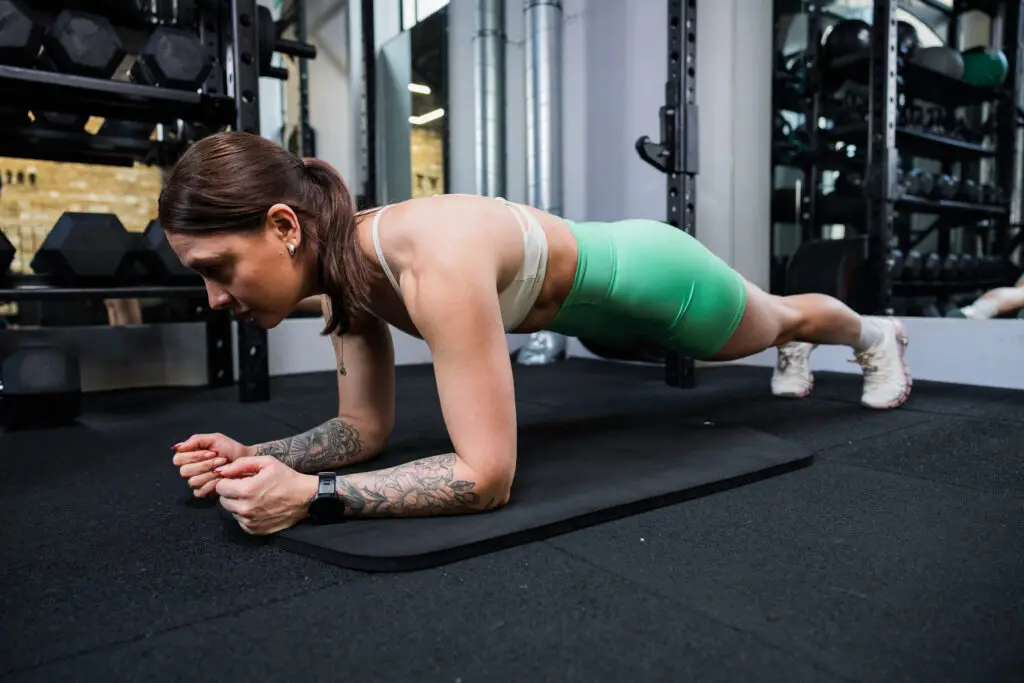
Conclusion: Your Path to Better Running Performance
This 12-week advanced push/pull/legs and core strength training program for runners provides a systematic approach to developing the strength that transforms running performance. The single-leg focus ensures direct transfer to running, whilst the progressive structure guarantees continuous improvement.
The 12reps app is your essential companion throughout this journey. With detailed exercise demonstrations, progress tracking, and program modifications, the app ensures you’re always training with perfect form and optimal progression. The built-in timer and rest period alerts keep your workouts efficient and effective.
Remember that consistency trumps perfection. Missing occasional sessions won’t derail your progress, but maintaining regular training will deliver the results you’re seeking. The combination of scientific programming and practical application makes this program suitable for runners of all levels who are ready to take their performance seriously.
Download the 12reps app to access exercise libraries, progress tracking, and join a community of runners committed to strength training excellence. The app’s social features allow you to share progress, get motivation, and learn from other runners following similar programs.
Strength training isn’t just an addition to your running program; it’s the foundation that allows you to run faster, longer, and injury-free. Start this program today with the 12reps app and experience the transformation that proper strength training brings to your running performance.
References
[1] Balsalobre-Fernández, C., Santos-Concejero, J., & Grivas, G. V. (2016). Effects of strength training on running economy in highly trained runners: a systematic review with meta-analysis of controlled trials. Journal of Strength and Conditioning Research, 30(8), 2361-2368. https://journals.lww.com/nsca-jscr/fulltext/2016/08000/effects_of_strength_training_on_running_economy_in.36.aspx
[2] Beattie, K., Kenny, I. C., Lyons, M., & Carson, B. P. (2014). The effect of strength training on performance in endurance athletes. Sports Medicine, 44(6), 845-865. https://link.springer.com/article/10.1007/s40279-014-0157-y
[3] Lauersen, J. B., Bertelsen, D. M., & Andersen, L. B. (2014). The effectiveness of exercise interventions to prevent sports injuries: a systematic review and meta-analysis of randomised controlled trials. British Journal of Sports Medicine, 48(11), 871-877. https://bjsm.bmj.com/content/48/11/871
[4] Phillips, S. M., & Van Loon, L. J. (2011). Dietary protein for athletes: from requirements to optimum adaptation. Journal of Sports Sciences, 29(S1), S29-S38.

